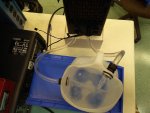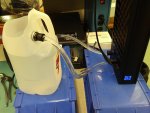I'm trying to fill and test an Eisbaer Extreme Solo I just got. (the pump/radiator unit without the CPU block) I ran tubes from the in/out ports to a jug of distilled water, using soft tubing and bulkhead fittings on the side of the jug. The results are not what I expected.
Since this is a test I am only powering the large "molex" power cable, assuming that the VPP755 will run at its preset speed without the PWM connection. Is this assumption correct?
The pump runs, and the unit filled with water, but the flow rate is MUCH less than I expected. I tilted the unit in all directions trying to get all of the air out of the radiator, but even after more than an hour I could still hear water splashing sounds inside the unit suggesting there is quite a bit of air trapped inside. I pulled the fill port plug and confirmed that the water was up to the top. Also, the flow rate is not constant, but changes unexpectedly. Most of the time the flow is slow, but at one point the water starting coming out very strong and fast for no obvious reason, and soon it was slow again. I can't trust putting together a working loop and installing the unit until I understand why it is running so weakly and inconsistently. Can you provide any suggestions?


Since this is a test I am only powering the large "molex" power cable, assuming that the VPP755 will run at its preset speed without the PWM connection. Is this assumption correct?
The pump runs, and the unit filled with water, but the flow rate is MUCH less than I expected. I tilted the unit in all directions trying to get all of the air out of the radiator, but even after more than an hour I could still hear water splashing sounds inside the unit suggesting there is quite a bit of air trapped inside. I pulled the fill port plug and confirmed that the water was up to the top. Also, the flow rate is not constant, but changes unexpectedly. Most of the time the flow is slow, but at one point the water starting coming out very strong and fast for no obvious reason, and soon it was slow again. I can't trust putting together a working loop and installing the unit until I understand why it is running so weakly and inconsistently. Can you provide any suggestions?







